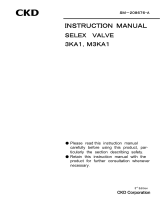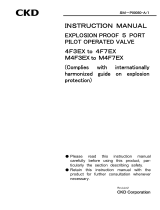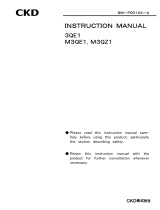Page is loading ...

Please read this instruction manual
carefully before using this product, par-
ticularly the section describing safety
Retain this instruction manual with the
product for further consultation whenever
necessary

1

2
’

3
UNPACKING (Section 3)
INSTALLATION (Section 4)
ENVIRONMENT (Section 4.1)

4
INSTALLATION (Section 4.2)

5
PIPING (Section 4.3)

6
AIR QUALITY (Section 5.2)
PERIODIC INSPECTION (Section 6.1)
DISASSEMBLING AND REASSEMBLING (Section 6.2)

7
INDEX
3KA1,4KA1, 4KB1
M3KA1, M4KA1, M4KB1
MASTER VALVE
Manual No. SM-206792-A/3
1. PART NAME AND DESCRIPTION 8
2. INTERNATIONAL SYSTEM OF UNITS (SI) 9
3. UNPACKING 10
4. INSTALLATION
4.1 Environment 11
4.2 Installation 12
4.3 Piping 13
5. OPERATING RECOMMENDATION
5.1 Operation 17
5.2 Air Quality 20
6. MAINTENANCE
6.1 Periodic Inspection 22
6.2 Disassembling and Reassembling 23
7. TROUBLE SHOOTING 27
8. PRODUCT SPECIFICATIONS AND HOW TO ORDER
8.1 Product Specifications 28
8.2 How to Order 31
8.3 Consumable parts 37

8
Direct piping unit Direct piping manifold
Subplate piping unit Subplate piping manifold
No. Part Name explanation
Master valve unit There are direct pipng and subplaate piping
Sub plate It is a block for the piping
Piping Port Port pis the supply port;port R is the exhaust port ; port A and B is
the Output port
Pilot air piping port It is pilot air,a supply port.(PA,PB)
Mounting screw There are two every individual valve and it fixes the valve unit on
the Various base.

9
In this manual, values are expressed using the International System of Units
(SI).
Use the table below to convert them into values expressed in conventional units.
Table of conversion between SI units and conventional units
(The values printed in Bolds fonts are values given in the International System of Units (SI)):
Force
N dyn kgf
1 1 105 1.01972 10-1
1 10-5 1 1.01972 10-6
9.80665 9.80665 1051
Stress
Pa or N/m2MPa or N/mm2kgf/mm2 kgf/cm2
1 1 10-6 1.01972 10-7 1.01972 10-5
1 106 1 1.01972 10-1 1.01972 10
9.80665 1069.80665 1 1 102
9.80665 1049.80665 10-2 1 10-2 1
Note 1Pa=1N/m2, 1MPa=1N/mm2
Pressure
Pa kPa MPa bar kgf/cm2 atm mmH2O mmHg or Torr
1 1 10-3 1 10-6 1 10-5 1.01972 10-5 9.86923 10-6 1.01972 10-1 7.50062 10-3
1 103 1 1 10-3 1 10-2 1.01972 10-2 9.86923 10-3 1.01972 1027.50062
1 106 1 103 1 1 10 1.01972 10 9.86923 1.01972 1057.50062 103
1 105 1 102 1 10-1 1 1.01972 9.86923 10-1 1.01972 1047.50062 102
9.80665 1049.80665 10 9.80665 10-2 9.80665 10-1 1 9.67841 10-1 1 104 7.35559 102
1.01325 1051.01325 1021.01325 10-1 1.01325 1.01323 1 1.03323 1047.60000 102
9.80665 9.80665 10-3 9.80665 10-6 9.80665 10-5 1 10-4 9.67841 10-5 1 7.35559 10-2
1.33322 1021.33322 10-1 1.33322 10-4 1.33322 10-3 1.35951 10-3 1.31579 10-3 1.35951 10 1
Note 1Pa=1N/m2
Example (converting a pressure value):
1kgf/cm20.0980665MPa 1MPa 1.01972 10kgf/cm2

10
a) Check the model number imprinted on the product to make sure that the
product you received is exactly the product you ordered.
b) Check the exterior of the product for any damage.
c) Before using the product, read the supplied documentation.

11
4.1 Environment

12
2
-
3.2
4.2 Installation
4.2.1 A work space for installation, removal, wiring, and piping opera-
tions should be provided around the installed master valve sys-
tem.
4.2.2 Direct mounting
1) Direct piping Type
Use two or four through holes
unit manifold
2) Sub plate piping Type
Use two mounting holes
unit manifold

13
4.3 Piping
Approproate torque
Joint screw Approproate torque N m
M5 to 1.5
Rc1/8 3 to 5

14
4.3.1 Sealant
Refrain applying sealant or seal tape approx.two pitches of thread from the
tip of pipe to avoid some of the sealing substances from falling into piping
system.
When winding the fluororesin seal tape on the screw part, wind the seal tape two
or three times where one or two screw threads remain at the top end of the screw,
and then push the tape by tip of the nail to make the tape tightly in contact with
the screw. When using the liquid sealant, apply a proper amount of sealant
where one or two screw threads remain at the top end of the screw.
At this time, do not apply the sealant to the female screw parts of the machine.
4.3.2 Flushing
Before connecting pipes, flush the interiors of the tubes, master valves, and
connected devices to remove foreign matter.
4.3.3 About M5 joint
M5 seal it with gasket (model:FGS). Don’t tight while increasing Pressure.
Consider a trouble of emergency, Design and enforce to be Possible to
remore and mount of a valve.
4.3.4 Blow circuit
Do not open the cylinder port circuit to the air because a drop in the air sup-
ply pressure may cause a malfunction.
4.3.5 Exhaust port
Minimize the restriction to the flow of the exhaust air because such re-
striction may cause a delay in the cylinder response. If such a delay hap-
pens, the speed needs to be adjusted between the cylinder and master valve.

15
4.3.6 Pipe connections
(1) Tubes to be used
For use with master valves with one-touch joints, select tubes of the type
specified by us: Soft nylon tubes (F-1500 Series)
Urethane tubes (U-9500 Series)
(2) For installation at a site that has spatters in the air, select incombustible
tubes or metal pipes.
(3) For a piping used for both hydraulic and pneumatic controls, select a hydrau-
lic hose.
When combining a spiral tube with a standard one-touch joint, fix the tube
origin using a hose band. Otherwise the rotation of the tube will decrease the
efficiency of the clamping.
For use in a high-temperature atmosphere, select fastener joints instead of
one-touch joints.
(4) When selecting from tubes commercially available, carefully study the accu-
racy of the outside diameter as well as the wall thickness and the hardness.
The hardness of an urethane tube should be 93 C or more (as measured by
a rubber hardness meter).
With a tube that does not have a sufficient accuracy of the outside diameter
or the specified hardness, a decrease in the chucking force may cause dis-
connection or difficulty in inserting.
Tube dimensions
Outside diameter
mm
Inside diameter mm
Nylon Urethane
4 2.5 2
6 4 4
8 5.7 5
10 7.2 6.5
(5) Minimum bending radius of tubes
Observe the minimum bending radius of tubes. Neglecting the minimum
bending radius may cause disconnection or leaks.
Tube bore Minimum bending radius mm
Nylon Urethane
4 10 10
6 20 20
8 30 30
10 40 40
Outside diameter allowance
Soft or hard nylon 0.1mm
Urethane 4, 6 +0.1mm
-0.15mm
Urethane 8, 10 +0.1mm
-0.2mm

16
(6) Cutting a tube
To cut a tube, use a tube cutter to cut the tube perpendicularly to the length
of the tube. Inserting an obliquely cut end of a tube may cause air leakage.
(7) Tube connections
Do not bend a tube immediately at where it is connected to the joint but lead
it out straight from the end of the joint for a length equal to or greater than
the outside diameter of the tube. The tension applied sideways through the
tube should not exceed 40N.
(8) Blank plug to be used
For use with a master valve with a one-touch joint, select the blank plug
specified by us: Blank plug GWP -B Series

17
5.1 OPERATION
3KA series
3KA111
When PB no pressurization (See the right figure)
B R2 (P port is closed.) B PB
When PB pressurization
P B (R2 port is closed.)
P R2
3KA1111
When PB no pressurization (See the right figure)
P A (R1 port is closed.)
When PB pressurization A PB
A R1 (P port is closed.)
R1 P
3KA121
When PA pressurization (See the right figure)
B R2
When PB pressurization
P B PA B PB
Even if air is cut off after press-
urization,it maintaing the chan-
ging by the self
P R2

18
4KA series
KA111
When PB no pressurization (See the right figure)
P A
B R2 (R1 port is closed.) A B PB
When PB pressurization
P B
A R1 (R2 port is closed.)
R1 P R2
4KA121
When PA pressurization (See the right figure)
P A
B R2 (R1 port is closed.) PA A B PB
When PB pressurization
P B
A R1 (R2 port is closed.)
Even if air is cut off after pressuri-
zation,it maintaing the changing by
the self
R1 P R2
4KA131, 4KA141, 4KA151
When 4KA131 is PA,PB no pressurization (See the right figure)
P A B R1 R2 are closed.
When 4KA141 is PA,PB no pressurization PA A B PB
P (Closed.)
A R1
B R2
When 4KA151 is PA,PB no pre-
ssurization
P A B
R1 R2 (Closed) R1 P R2
Refer to the function of 4KA121 concerning the case of PA or PB which is
pressurization

19
2) 4KBseries
4KB111
When PB no pressurization (See the right figure)
P A PB
B R
When PB pressurization
P B
A R
A P B R
4KB121
When PA pressurization (See the right figure)
P A
B R PA PB
When PB pressurization
P B
A R
Even if air is cut off after press-
urization,it maintaing the chan-
ging by the self
A P B R
4KB131, 4KB141, 4KB151
When 4KA131 is PA,PB no pressurization (See the right figure)
P A B R are closed.
When 4KA141 is PA,PB no pressurization
P (Closed.)
A B R PA PB
When 4KA151 is PA,PB no
pressurization
P A B
R (Closed.)
Refer to the function of 4KB121
concerning the caseof PA or PB
which is pressurization A P B R
/












